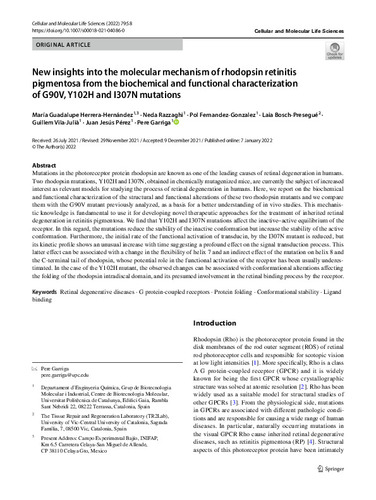New insights into the molecular mechanism of rhodopsin retinitis pigmentosa from the biochemical and functional characterization of G90V, Y102H and I307N mutations

Cita com:
hdl:2117/383863
Tipus de documentArticle
Data publicació2022-01-01
EditorSpringer Nature
Condicions d'accésAccés obert
Llevat que s'hi indiqui el contrari, els
continguts d'aquesta obra estan subjectes a la llicència de Creative Commons
:
Reconeixement-NoComercial-SenseObraDerivada 4.0 Internacional
Abstract
Mutations in the photoreceptor protein rhodopsin are known as one of the leading causes of retinal degeneration in humans.
Two rhodopsin mutations, Y102H and I307N, obtained in chemically mutagenized mice, are currently the subject of increased
interest as relevant models for studying the process of retinal degeneration in humans. Here, we report on the biochemical
and functional characterization of the structural and functional alterations of these two rhodopsin mutants and we compare
them with the G90V mutant previously analyzed, as a basis for a better understanding of in vivo studies. This mechanis-
tic knowledge is fundamental to use it for developing novel therapeutic approaches for the treatment of inherited retinal
degeneration in retinitis pigmentosa. We find that Y102H and I307N mutations affect the inactive–active equilibrium of the
receptor. In this regard, the mutations reduce the stability of the inactive conformation but increase the stability of the active
conformation. Furthermore, the initial rate of the functional activation of transducin, by the I307N mutant is reduced, but
its kinetic profile shows an unusual increase with time suggesting a profound effect on the signal transduction process. This
latter effect can be associated with a change in the flexibility of helix 7 and an indirect effect of the mutation on helix 8 and
the C-terminal tail of rhodopsin, whose potential role in the functional activation of the receptor has been usually underes-
timated. In the case of the Y102H mutant, the observed changes can be associated with conformational alterations affecting
the folding of the rhodopsin intradiscal domain, and its presumed involvement in the retinal binding process by the receptor.
CitacióHerrera-Hernandez, M. [et al.]. New insights into the molecular mechanism of rhodopsin retinitis pigmentosa from the biochemical and functional characterization of G90V, Y102H and I307N mutations. "Cellular and Molecular Life Sciences", 1 Gener 2022, vol. 79, núm. 58, p. 1-15.
ISSN1420-9071
Versió de l'editorhttps://link.springer.com/article/10.1007/s00018-021-04086-0
Altres identificadorshttps://pubmed.ncbi.nlm.nih.gov/34997336/
| Fitxers | Descripció | Mida | Format | Visualitza |
|---|---|---|---|---|
| 18_2021_Article_4086.pdf | 1,452Mb | Visualitza/Obre | ||
| Herrera-Hernánd ... htsIntoTheMolecularMec.pdf | 1,541Mb | Visualitza/Obre |


